One of the most exciting developments in recent years has been the rise of Retail Media and the opportunities for both online and offline Retailers. It offers a huge revenue potential for Retailers across channels and business sizes, as digitalization and the availability of data enables them to better monetize their highly relevant net reach among actual buyers along the customer journey.
The Rise of Retail Media
The growth of retail media has been driven by the increasing popularity of e-commerce platforms. Forecast Zenith calculates that retail media already accounted for 20% of all online ad spend – the equivalent of 77 billion USD – and expects that advertising spends on Retail Media to grow to 27% in 2024.
Online Pure Players like Amazon, eBay and Otto have been growing their Retail Media Business with own entities for many years now. More recently, omnichannel Retailers like Mediamarkt, OBI, dm, Metro, Schwarz (Kaufland/Lidl) have also heavily advanced and promoted their offerings. Today Retail Media already accounts for 20% of all online advertising spend globally.
Traditionally, digital advertising has been dominated by media players like Google and Meta, with brands spending billions of dollars on search ads and social media marketing. However, with the growing popularity of retail media, brands now have another relevant channel to reach actual buyers in a very targeted and effective way, both online and offline.
Retailers with a professionalized Retail Media offering already provide a range of advertising options, including sponsored products, sponsored brands, and sponsored display ads, all designed to help brands reach their target audience – online or instore.
Advantages of Retail Media vs traditional advertising
Current market and consumer trends have combined to deliver the perfect conditions for retail media to succeed, because it offers several advantages over traditional advertising methods.
- Influencing the vital moment
First and foremost, advertising on retailer websites or instore allows brands to reach consumers at the moment they are most likely to make a purchase. It’s the perfect touchpoint to capture attention right within the heart of the consumer journey, with shoppers already fully engaged and in a decision-making mindset.
When a consumer is searching for a product at a Retailer, they are already in a buying mindset. By placing ads directly on these platforms, brands can catch consumers at the right moment, place and time – increasing the likelihood of conversion and sales growth.
- Rising popularity of retailer websites in shoppers’ buying journeys
Not only is the influence of online advertising in general on the up, but retailer websites in particular are gaining traction.
In Germany, 44% of people shopping for tech and durable products in Q4 2022 visited at least one retailer website during their shopper journey. That’s a +18 percentage point jump from the 26% doing so in Q4 2018.
In contrast, just 10% of Germany’s TV buyers in Q4 2022 were triggered by retailer leaflets. That’s -4 percentage points lower than in the same period the year before.
- Retail media offers a wealth of data to fuel more effective advertising
By getting access to how consumers search and purchase on a retailer’s website or through digitized instore methods (e.g. using smart cards, computer vision or loyalty cards), brands can gain valuable insights into their customers’ needs, preferences, triggers and buying habits. This information can then be used to create more targeted and effective advertising campaigns and to measure return-on-investment.
- Cost effectiveness of retail media
When done well, Retail Media can often be more cost-effective than most traditional advertising methods and support both sales uplift and brand uplift. Because brands are only targeting consumers who are immediately engaged in searching for their products, they avoid wasting money compared to other ads that may not reach the most relevant audience. In addition, many Retailers offer a range of advertising options that cater to different budgets, making it accessible to businesses of different sizes.
The Future of Retail Media – the increasing challenge from competition
With e-commerce and instore digitalization continuing to grow, it’s clear that retail media will play an increasingly important role in the advertising landscape. Brands that want to stay competitive will need to embrace retail media and invest in this area.
However, the future of retail media is not without its challenges. As more brands flock to these platforms, competition for ad space will increase, driving up the cost of advertising. In addition, privacy concerns around data collection and targeting may lead to stricter regulations and limitations on how Retailers and brands can use consumer data.
Despite these challenges, the potential benefits of retail media are too great to ignore. By reaching consumers at the moment when they are most likely to make a purchase decision, and by being able to gain valuable insights into their target audience’s behaviour during their purchase journey, brands can create more effective advertising campaigns and drive sales and brand awareness in a highly competitive space.
4 steps to drive a successful Retail Media strategy
- Identify & understand. The first step is to identify the high potential advertisers who are right for your specific Retail Media offering (instore and online). The manufacturers and brands with matching target groups to yours, who are facing challenges reaching their audience, and who have relevant products. But there is more than that. You also need deep understanding of their markets, products, needs and target audience.
- Showcase & sell. Next is to grab the attention of your identified, ideal advertisers. To carry weight here, Retailers need independent stats to prove their relevance as a touchpoint with the target audience, their strong online and offline ROI stats, and, ideally, a NPS that’s higher than competitors.
- Prepare & deliver. Phase three is all about delivering best in class service to your advertisers. To drive uplift and conversion Retailers need to be thinking in terms of pre-testing, leveraging insights on target specific needs, catalogue data, stats on seasonal top sellers, and micro-geographic insights to truly fine-tune the advertising. Ideally, you’ll also be able to give your advertisers guidance on cross-channel touchpoints, to support them in their marketing mix calculations.
- Succeed & repeat. Finally, you need to keep your advertisers optimized for success. The more you can help them succeed, the more they will spend in advertising via your site. Benchmark your advertisers’ performance against their competition and provide them with the stats from marketing mix modelling and brand uplift evaluation that prove the ROI of your site versus other channels in driving an uplift in online and/or offline sales.
GfK’s world-leading, neutral data provides you with all of the statistics, insights and recommendations you need to achieve your best results in the four steps above. Full understanding of retailers’ markets, products, and target audiences, alongside the ability to demonstrate and and quantify your overlapping target groups and the sales performance against the overall market.
Like to know more? Explore the full support we provide to Retailers:




